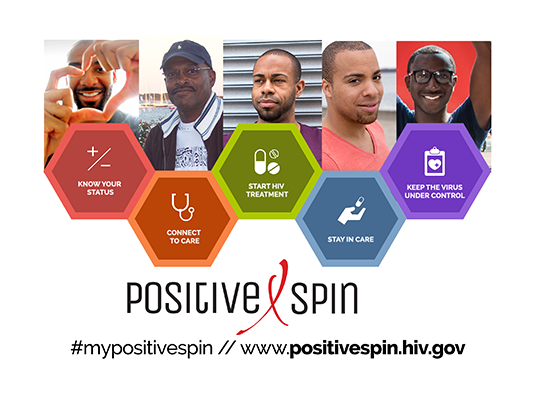Stories Have an Impact
Topics

As a result of our interactions with our partners and stakeholders, HIV.gov recognized the importance of stories in raising awareness about HIV—particularly for those at greatest risk. That’s why the first series in our digital storytelling project, Positive Spin, focused on the real-life stories of five black gay men—a group that has been disproportionately affected by HIV—as a way of demonstrating that people who get appropriate and continuous treatment can live well with HIV.
Lately, we have been following an increasing number of conversations and stories about black gay and bisexual men (BMSM for black men who have sex with men) on social media and in the press. These discussions are extremely important because they continue to call our attention to the specific HIV-related issues faced by black/African American gay and bisexual men:
African American gay and bisexual men account for more U.S. HIV diagnoses than any other group defined by gender, race/ethnicity, and transmission risk—39% of all diagnoses in 2015.1
Among all BMSM, young BMSM (ages 13-24) had the highest percentage of new HIV diagnoses in 2015—38% of cases.2
The latest data from CDC show an 18% reduction in the overall number of new HIV infections in the United States from 2008 to 2014.3 HIV infections declined for most groups during this time, but the reductions were larger in some groups than others. Among white MSM, there was an 18% decrease in new HIV infections, but among black MSM, new infections were stable—meaning that they did not show a meaningful increase or decrease over time. And there was a worrisome increase in new HIV infections among Latino MSM. The stability in new HIV infections among black MSM and the increase among Latino MSM stood in stark contrast to the declines seen in other groups.
We continue to be very concerned that these large disparities exist, but it’s good to see that they have been a focus of attention this week. Sharing this information and the stories of the people whose lives have been affected is an important way of raising awareness. Creating opportunities that allow people to tell their own life stories are critically important in giving support to people at risk for, and living with, HIV.
That is why we created Positive Spin. We know that written personal stories, in-person presentations by people living with HIV, radio dramas, and telenovelas have all been used successfully to share personal stories that can reduce stigma, decrease risk behaviors, and help people living with HIV and others to learn from the experiences of people like them. When we were developing the series, one of the things that we heard from young men who had tested positive for HIV was “I thought my life was over.” The five men of Positive Spin powerfully demonstrate that does not have to be the case. People with HIV who are diagnosed early and get appropriate, continuous treatment are much more likely to live a near-normal life-span. Stories like those of Paul, Uriah, Patrick, Guy, and Ken help to dispel misinformation about living with HIV and inspire hope and action—exactly the steps we need to take to end HIV and AIDS among BMSM.
Please take a few moments to view some of the Positive Spin videos and share them with your colleagues and friends. Think about the stories that you, your staff, and your clients have to tell. Then get out there and start sharing them to remind people that, although we have the tools to end HIV and the desire to do so, we must get those tools to the right people in the right way to truly end the spread of HIV here and around the world.
1. https://www.cdc.gov/hiv/group/msm/bmsm.html
2. https://www.cdc.gov/hiv/group/msm/bmsm.html
3. https://www.cdc.gov/nchhstp/newsroom/2017/croi-hiv-incidence-press-release.html